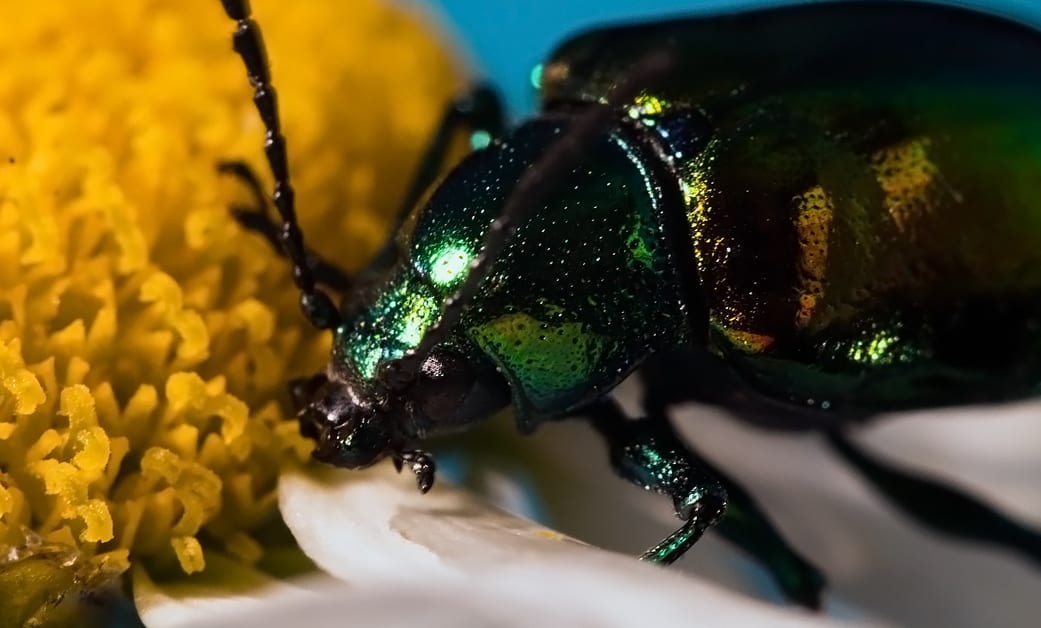Have you ever looked at the shimmer of a peacock's feathers or the metallic shine of a green June beetle and thought, “I bet those bright colors help that animal blend in with its natural habitat.†No? Well, you wouldn't be alone. When artist and naturalist Abbot Thayler first proposed that iridescence could be a form of camouflage, his ideas were soundly rejected. However, scientists may have proven the Father of Camouflage's theory right; both animals and people use conspicuous camouflage such as bright colors and bold patterns to confuse predators and attackers.

To start, camouflage usually falls into one of two categories: masquerade or disruptive coloration. While you may be familiar with masquerade camouflage that enables animals to mimic their surroundings, disruptive coloration instead uses distinct color patterns to break up the appearance or outline of an animal. This makes it hard for predators to recognize the shape of prey and accurately aim for their target. For example, a zebra's black and white stripes may stand out when the zebra is alone, but in a herd, their stripes make it difficult to tell one from another.

While iridescence has primarily been thought of as a signal to identify potential mates or poisonous prey, it is also common among animals that do not need these signals, including certain insects. What then could iridescence be used for?
As a visual phenomenon, iridescence varies the hue (color) and intensity (brightness) over the surface of an object depending on what angle you look at it. So if an iridescent insect has distinct color differences, a predator might find it difficult to identify the insect as a whole object, effectively giving the insect disruptive coloration. To further support this idea, researchers recently discovered that bees have a harder time identifying iridescent shapes when compared to non-iridescent shapes. While the investigators do acknowledge that bees are not predators, they did note that bees' vision is similar to other types of predatory hornets and wasps. In addition, bee vision is well studied, which makes them a good model to use for understanding how predatory insects see.
Knowing that bees have a difficult time seeing iridescence is not just an interesting fact; studying nature can also lead to the innovation of helpful technologies. One example of a human use of conspicuous camouflage was the invention of razzle dazzle camouflage during World War I. At the time, newly invented German U-boats were wreaking havoc on the American and British navies. While the U-boats still had to sight the ships by eye, they were often successful at not only damaging the warships but sinking them as well. Over 5,000 ships were sunk by U-boat torpedos, resulting in nearly 15,000 lost lives. In order to defend against the U-boats, the U.S. and British navies turned to naturalists and inventors to find a way to camouflage their ships. Inspired by zebras' disruptive stripes, British reserve volunteer Norman Wilkinson came up with the idea not to hide the ships, but to paint them in distinct and intersecting patterns that prevented torpedo operators from accurately taking aim. Over the course of WWI, dazzle painting adorned over 2,000 ships and was a successful defense against the U-boat torpedoes.

While we probably won't start painting that many things in a rainbow of iridescent colors or bold patterns any time soon, artists, inventors, and scientists are often inspired by nature to create new materials and technologies. Researchers are currently investigating the nanostructure of naturally occurring iridescent materials in order to develop new, low energy display technologies. Others may simply use nature's methods in art and interior design. In either case, we can and should look to nature not only to understand our history but also to imagine what we can create for the future.
About the Author
 Mackenzie Carter currently serves as an Assistant Editor for Athens Science Observer and recently graduated from the University of Georgia with a master's degree in Comparative Biomedical Sciences. With her background in biomedical and tissue engineering, she is fascinated by bioinspired design and photobiology. Mackenzie is currently looking for a position as a research/science communicator at a public research institution. In her free time, she explores her passions: cephalopods, ceramics, tea, and west coast swing dancing. You can connect with Mackenzie via email at mackenziecarter@uga.edu. Mackenzie Carter currently serves as an Assistant Editor for Athens Science Observer and recently graduated from the University of Georgia with a master's degree in Comparative Biomedical Sciences. With her background in biomedical and tissue engineering, she is fascinated by bioinspired design and photobiology. Mackenzie is currently looking for a position as a research/science communicator at a public research institution. In her free time, she explores her passions: cephalopods, ceramics, tea, and west coast swing dancing. You can connect with Mackenzie via email at mackenziecarter@uga.edu. |
About the Author
- athenssciencecafehttps://athensscienceobserver.com/author/athenssciencecafe/April 17, 2020
- athenssciencecafehttps://athensscienceobserver.com/author/athenssciencecafe/April 12, 2020
- athenssciencecafehttps://athensscienceobserver.com/author/athenssciencecafe/April 3, 2020
- athenssciencecafehttps://athensscienceobserver.com/author/athenssciencecafe/March 30, 2020







